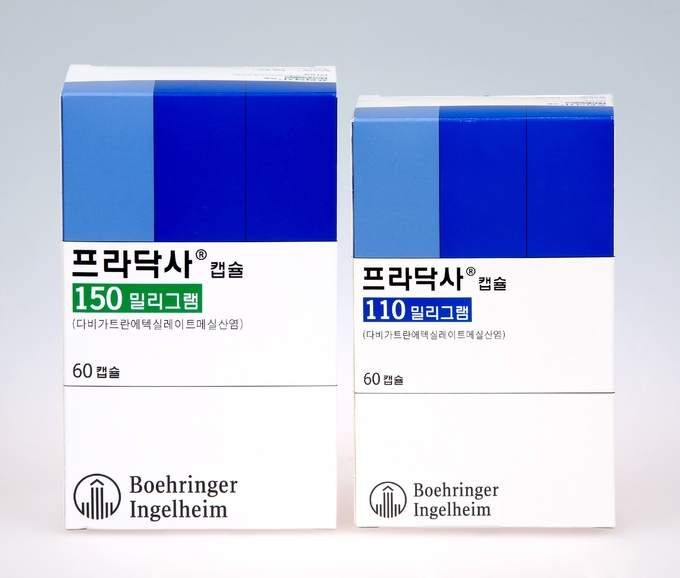경피적 관상동맥 중재술(PCI) 받은 심방세동(AF) 환자를 대상으로 한 
새로운 항응고제(NOAC) 관련 조사 드물어 효과적인 항혈전 요법을 찾는
의료진에게 유의미한 데이터 제시
2017 유럽심장학회(ESC)에서 연구 결과 공개1동시에
뉴잉글랜드 저널 오브 메디슨(NEJM) 게재2
베링거인겔하임은 RE-DUAL PCI™ 연구 결과에서, 경피적 관상동맥 중재술(PCI)과 스텐트 시술을 받은 비판막성 심방세동(non-valvular atrial fibrillation, NVAF) 환자에서 프라닥사®(성분명: 다비가트란에텍실레이트메실산염) 이중요법이 와파린 삼중요법 대비 주요 출혈사건 또는 임상적으로 관련된 출혈사건 발생율이 더 낮게 나타났다고 밝혔다.1,2
RE-DUAL PCI™ 연구에는 경피적 관상동맥 중재술(PCI)과 스텐트 시술을 받은 비판막성 심방세동(NVAF) 환자 총 2,725명이 포함됐으며, 이 결과는 스페인 바르셀로나에서 열린 2017 유럽심장학회(European Society of Cardiology, ESC) 최신 임상 연구 세션에서 발표된 동시에1 뉴잉글랜드 저널 오브 메디슨(New England Journal of Medicine, NEJM)에 게재됐다. 2
이번 연구 결과에 따르면, 주요 출혈 또는 임상적으로 관련된 출혈사건 발생률이 프라닥사® 110mg 이중요법을 받은 환자군은 981명 중 151명(15.4%)에서, 와파린 삼중요법은 환자군 981명 중 264명(26.9%)에서 나타나, 일차 평가변수에서 상대적으로 48%의 위험 감소를 보였다. 또한, 프라닥사® 150mg 이중요법에서도 763명 중 154명(20.2%)이, 와파린 삼중요법은 764명 중 196명(25.7%)에서 주요 출혈 또는 임상적으로 관련된 출혈사건이 발생하여 일차 평가변수에서 상대적으로 28%의 위험 감소를 보였다. 사망, 심근경색, 뇌졸중, 전신색전증, 계획하지 않은 재관류술의 복합 발생 등의 이차 평가변수에서는 프라닥사®와 와파린 군 간에 대등한 수준이었다. (프라닥사®이중요법 13.7%, 와파린 삼중요법 13.4%) 1,2
이번 연구를 주도한 미국 브리검 여성 병원(Brigham and Women's Hospital) 심장전문의이자 바임임상연구소(Baim Institute for Clinical Research) 심혈관대사 임상 디렉터인 크리스토퍼 캐넌(Christopher Cannon) 박사는 “스텐트 시술을 경험한 심방세동 환자를 치료하는 의사에게는 치료제의 효과와 출혈 위험 간의 균형을 유지하는 게 무엇보다 중요하다”며 “새로운 항응고제(NOAC)에 대한 전용 데이터가 많지 않던 상황에서 프라닥사®를 활용한 이번 RE-DUAL PCI™ 연구 결과는 효과적인 항혈전 요법을 찾는 의료진에게 유의미한 데이터가 될 것으로 보인다”고 밝혔다.
뇌졸중 위험 때문에 경구용 항응고제(OAC)를 지속 복용하는 심방세동(AF) 환자 가운데 약 20-30%는 관상동맥질환을 동반하기 때문에 심장 혈류 개선을 위해 스텐트를 삽입하는 경피적 관상동맥 중재술(PCI)이 필요할 수 있다. 3 이들 환자에게는 강력한 항혈전 요법으로 와파린과 2개의 항혈소판제로 구성된 삼중요법을 사용하는데, 주요 출혈사건 발생률이 높다는 단점이 있다. 4-7 RE-DUAL PCI™ 연구 결과는 이러한 상황에서 아스피린 없이 새로운 경구용 항응고제(NOAC)인 프라닥사®와 1개의 항혈소판제로 구성된 이중요법의 효과를 평가한 것이다.
베링거인겔하임 심혈관계 사업부 의학 부사장인 외르크 크로이처(Jörg Kreuzer) 교수는 “RE-DUAL PCI™ 연구에서 나온 결과는 프라닥사®가 심방세동(AF) 환자와 이들을 치료하는 의료진에게 제공할 수 있는 또 하나의 위대한 근거를 나타낸다”며 “이러한 이점은 카테터 절제술에서 RE-CIRCUIT® 연구, 리얼 월드(real-world) 연구 또는 응급 상황에서의 RE-VERSE AD™ 연구 등 많은 치료 상황에서 관찰됐는데,1,2,8-18 이들 데이터는 모두 프라닥사®의 안전성과 유효성을 잘 보여주는 것으로 의미가 있다”고 언급했다.
RE-DUAL PCI™ 연구는 심방세동(AF) 환자의 뇌졸중 위험 감소를 위한 최초의 경구용 항응고제(NOAC)인 프라닥사®를 출시한19,20 베링거인겔하임이 환자와 의료진을 위해 진행하는 항응고 치료 혁신의 일환으로 진행됐다. 베링거인겔하임은 응급 상황에서 프라닥사®의 항응고 효과를 역전시키기 위해 사용하는 최초의 특이적 항응고 역전제인 프락스바인드®(성분명: 이다루시주맙)를 2015년 미국, 유럽에서 승인 받았으며 2016년 한국에서 허가 승인 받았다.21,22,23 프락스바인드®는 미국, 일본 등 전세계 7,500개 이상의 병원에서 널리 사용되고 있다.24
References
1. Cannon CP. et al. RE-DUAL PCI: Dual Antithrombotic Therapy with Dabigatran after Percutaneous Coronary Intervention in Patients with Atrial Fibrillation, ESC Congress, Barcelona, 2017, Abstract 1920.
3. Lip G. et al. Antithrombotic management of atrial fibrillation patients presenting with acute coronary syndrome and/or undergoing coronary stenting: executive summary—a Consensus Document of the European Society of Cardiology Working Group on Thrombosis, endorsed by the European Heart Rhythm Association (EHRA) and the European Association of Percutaneous Cardiovascular Interventions (EAPCI). European Heart Journal. 2010;31:1311–18.
4. Coppens M. and Eikelboom JW. Antithrombotic Therapy After Coronary Artery Stenting in Patients With Atrial Fibrillation Circ Cardiovasc Interv. 2012;5:454–5.
5. Nikolsky E. et al. Outcomes of patients treated with triple antithrombotic therapy after primary percutaneous coronary intervention for ST-elevation myocardial infarction (from the Harmonizing Outcomes With Revascularization and Stents in Acute Myocardial Infarction [HORIZONS-AMI] trial). Am J Cardiol. 2012;109:831–838.
6. Andrade JG. et al. Risk of bleeding on triple antithrombotic therapy after percutaneous coronary intervention/ stenting: a systematic review and meta-analysis. Can J Cardiol. 2013; 29:204–212.
7. Verheugt FW. Triple antithrombotic therapy after coronary stenting in the elderly with atrial fibrillation: necessary or too hazardous? AmHeart J. 2012;163:531–534.
8. Calkins H. et al. Uninterrupted Dabigatran versus Warfarin for Ablation in Atrial Fibrillation. NEJM. 2017. DOI: 10.1056/NEJMoa1701005.
9. Pollack, C.V. et al. Idarucizumab for Dabigatran Reversal – Full Cohort Analysis. NEJM. 2017; DOI: 10.1056/NEJMoa1707278. www.nejm.org/doi/full/10.1056/NEJMoa1707278
10. Graham DJ et al. Cardiovascular, Bleeding, and Mortality Risks in Elderly Medicare Patients Treated With Dabigatran or Warfarin for Nonvalvular Atrial Fibrillation. Circulation 2015;131:157–64.
11. Graham DJ et al. Stroke, Bleeding, and Mortality Risks in Elderly Medicare Beneficiaries Treated With Dabigatran or Rivaroxaban for Nonvalvular Atrial Fibrillation. JAMA Intern Med 2016;176:1662–71.
12. Chan Y-H et al. Cardiovascular, Bleeding, and Mortality Risks of Dabigatran in Asians With Nonvalvular Atrial Fibrillation. Stroke 2016;47:441–9.
13. Larsen TB et al. Comparative effectiveness and safety of non-vitamin K antagonist oral anticoagulants and warfarin in patients with atrial fibrillation: propensity weighted nationwide cohort study. BMJ 2016;353:i3189.
14. Lip GYH et al. Real-world comparison of major bleeding risk among non-valvular atrial fibrillation patients initiated on apixaban, dabigatran, rivaroxaban, or warfarin. A propensity score matched analysis. Thromb Haemost 2016;116(5):975–986.
15. Al-Khalili F et al. The safety and persistence of non-vitamin-Kantagonist oral anticoagulants in atrial fibrillation patients treated in a well structured atrial fibrillation clinic. Curr Med Res Opin 2016;32:779–85.
16. Deitelzweig S et al. An early evaluation of bleeding-related hospital readmissions among hospitalized patients with nonvalvular atrial fibrillation treated with direct oral anticoagulants. Curr Med Res Opin 2016;32:573–82.
17. Hernandez I et al. Comparing Stroke and Bleeding with Rivaroxaban and Dabigatran in Atrial Fibrillation: Analysis of the US Medicare Part D. DataAm J Cardiovasc Drugs 2016;doi:10.1007/s40256-016-0189-9.
18. Gorst-Rasmussen A et al. Rivaroxaban versus warfarin and dabigatran in atrial fibrillation: comparative effectiveness and safety in Danish routine care. Pharmacoepidemiol Drug Saf 2016;25:1236–44.
19. Pradaxa® European Summary of Product Characteristics, 2017.
20. PRADAXA US Prescribing Information, 2014.
21. Praxbind® European Summary of Product Characteristics, 2016.
22. PRAXBIND US Prescribing Information, 2015.
23. 프락스바인드® 주사제 식약처 허가사항, 2017
24. Boehringer Ingelheim Data on File.



